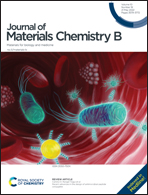Mussel-inspired bioactive 3D-printable poly(styrene-butadiene-styrene) and the in vitro assessment of its potential as cranioplasty implants†
Abstract
Challenges in cranial defect reconstruction after craniotomy arise from insufficient osteogenesis and biofilm infection, which requires novel biomaterials. Herein, we propose a mussel-inspired bioactive poly(styrene-butadiene-styrene) (SBS) as a promising cranioplasty material. The catechol-modified quaternized chitosan (QCSC) was employed in the bio-inert surface of 3D-printed SBS to provide the contact-killing ability against bacterial biofilms. The polydopamine-decorated zeolitic imidazolate framework-8 (pZIF-8) and polydopamine hybrid hydroxyapatite (pHA) were further modified on the surface to further enhance the antibacterial property and osteogenesis activity, effectively killing bacteria by no less than two orders of magnitude and significantly facilitating osteogenic gene expression and mineralization. Due to the lack of research using SBS as a cranioplasty material, we believe that the modified SBS materials developed in this study and the in vitro assessment may be beneficial for developing novel cranioplasty implants.



 Please wait while we load your content...
Please wait while we load your content...